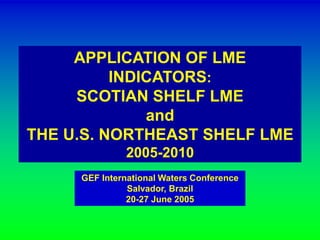
Application of LME Indicators: Scotian Shelf LME and the US Northeast Shelf LME 2005-2010
- 1. APPLICATION OF LME INDICATORS: SCOTIAN SHELF LME and THE U.S. NORTHEAST SHELF LME 2005-2010 GEF International Waters Conference Salvador, Brazil 20-27 June 2005
- 2. 10 U.S. LMEs
- 3. THE SCOTIAN SHELF LME
- 4. From: Frank, Petrie, Choi, and Leggett. 2005. Trophic cascades in a formerly cod-dominated ecosystem. Science 308:1621.
- 5. CHANGING CONDITIONS From: Choi, Frank, Leggett, and Drinkwater, 2004. Transition to an alternate state in a continental shelf ecosystem. Can. J. Fish. Aquat. Sci. 61:505-510
- 7. PRODUCTIVITY INDICATORS An undulating oceanographic recorder (above), towed behind a ship, is used to collect ecological parameters needed to assess the state of the marine ecosystem (left).
- 9. Climate Drivers of the Northeast Shelf Ecosystem • Warm Gulf Stream waters • Cold Scotian Shelf incursions • Winter North American cold air • Warm Gulf of Mexico air • Position of westerly North American jet air stream from O. Hertzman, 1996
- 10. General Circulation of the Northeast Shelf Ecosystem
- 16. FISH AND FISHERIES INDICATORS • Demersal species surveys • Pelagic species surveys • Ichthyoplankton surveys • Invertebrate surveys (clams, scallops, shrimp, lobster, squid) • Essential fish habitat • Marine protected areas
- 17. COMMON TERMS from Our Living Oceans Report • Recent average yield (RAY) • Current potential yield (CPY) • Long term potential yield (LTPY) • Stock level relative to LTPY • Status of resource utilization • Threatened or endangered • Potential biological removal (PBR / MMPA)
- 18. 500 400 300 200 100 0 4000 3500 3000 2500 2000 HERRING Spawning Stock Biomass Commercial Landings 1966 1970 1980 1990 1998 1500 1000 500 0 Year Spawning Biomass (metric tons, 000s) Landings (metric tons, 000s) 2500 2000 1500 1000 MACKEREL Spawning Stock Biomass Commercial Landings 1962 1970 1980 1990 1998 Year 500 400 300 200 100 0 500 0 Spawning Biomass (metric tons, 000s) Landings (metric tons, 000s) Figure 6-8. Top - Atlantic herring commercial landings and spawning stock biomass, 1967 through 1996 (thousand metric tons). Bottom - Atlantic mackerel landings and spawning stock biomass, 1963 through 1996 (thousand metric tons).
- 19. Georges Bank Yellowtail 1.0 0.8 0.6 0.4 0.2 1975 1980 1985 1990 1995 2000 Year Spawning Stock Biomass ('000 mt) & Recruitment (millions, age 1) 80 70 60 50 40 30 20 10 0 Exploitation Rate 0.0 Spawning Stock Biomass Recruitment Exploitation Rate
- 20. Georges Bank Haddock 0.40 0.35 0.30 0.25 0.20 0.15 0.10 0.05 1975 1980 1985 1990 1995 2000 Year Spawning Stock Biomass ('000 mt) & Recruitment (millions, age 1) 120 100 80 60 40 20 0 Exploitation Rate 0.00 Spawning Stock Biomass Recruitment Exploitation Rate
- 21. Georges Bank Cod 1980 1985 1990 1995 2000 6 5 4 3 2 1 Age2 Age3 Age4 Age5 Weight at age, kg Year
- 22. Georges Bank Haddock 1965 1970 1975 1980 1985 1990 1995 2000 3 2 1 Age2 Age3 Age4 Age5 Weight at age, kg Year
- 23. Georges Bank Yellowtail 0.9 Age2 1975 1980 1985 1990 1995 2000 0.8 0.7 0.6 0.5 0.4 0.3 Age3 Age4 Age5 Weight at age, kg Year
